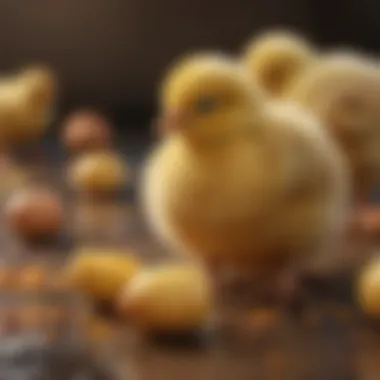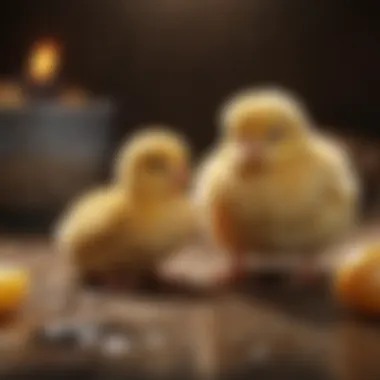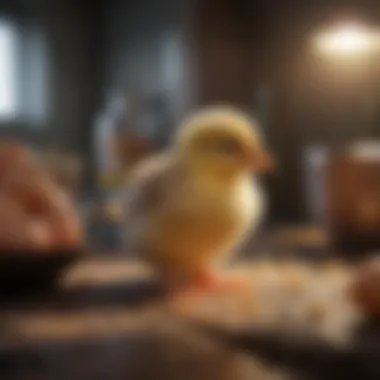Essential Nutrition for Newly Hatched Chicks


Intro
Proper nutrition during the early days of newly hatched chicks is critical for their overall growth and development. Nutrition plays a fundamental role in enhancing their immune systems, supporting vital organ development, and establishing a strong foundation for their future health. Understanding their dietary needs not only aids caregivers but also ensures the chicks thrive in various environments. This comprehensive guide aims to provide detailed insights into the nutritional components essential for newly hatched chicks, as well as practical advice on feeding practices.
Animal Overview
Common Name and Scientific Classification
The common name for the domesticated bird is the chick, scientifically classified as Gallus gallus domesticus. They are a subspecies of the red junglefowl, a bird native to Southeast Asia. Chicks are the immature form of chickens and exhibit unique growth patterns and needs that differ significantly from adult chickens.
Physical Characteristics
Newly hatched chicks are typically small, weighing around 30 to 35 grams at birth. They possess soft, downy feathers, which may vary in color depending on their breed. At this stage, their eyes are large relative to their heads, and their legs are thin yet strong enough to support movement shortly after hatching. As they grow, they gradually replace their down with feathers, transitioning from the dependent stage of chickhood into independence.
Habitat and Distribution
Chicks are commonly found in domesticated environments, such as farms and backyards, across the world. They are highly adaptable birds that can thrive in a variety of habitats. However, their optimal conditions include safe shelter from predators, access to clean water, and adequate space for movement and foraging. Understanding their habitat requirements is crucial for ensuring their health and wellbeing.
Importance of Nutrition for Newly Hatched Chicks
Newly hatched chicks require specialized nutrition for achieving healthy growth rates. The first few days of a chick's life are critical, where they depend on the nutrients available in their yolk sac. This energy source must be supplemented with a suitable diet soon after hatching.
Important: The transition from yolk sac to external feeding should happen within the first 24 hours of hatch.
Nutritional Components Essential for Development
Essential nutrients for newly hatched chicks include:
- Proteins: Crucial for muscle development and repair. Ideal sources are high-quality chick starter feeds that contain at least 18% protein.
- Carbohydrates: Provide energy for growth. They can be sourced from grains and other carbohydrate-rich feeds.
- Vitamins and Minerals: Vital for metabolic processes and overall health. Special attention is needed for calcium and vitamin D for bone development.
Feeding Practices
Feeding newly hatched chicks involves more than just providing food; it includes creating a stable feeding environment. Some important practices include:
- Start feeding with a complete chick starter feed specifically designed for their age.
- Ensure fresh water is available at all times. This is essential for hydration and digestion.
- Avoid feeding whole grains or seeds until chicks are older, as they may not be able to digest them properly.
Common Pitfalls in Chick Nutrition
Caregivers should be aware of common mistakes that can adversely affect chick growth. For instance:
- Overfeeding can lead to obesity and health problems.
- Providing adult chicken feed will not meet the nutritional requirements of chicks.
- Failing to ensure proper hydration can lead to serious health issues.
Transitioning to a Balanced Diet
As chicks mature, their dietary needs change. Transitioning them to a balanced diet during the growing phase is essential. This transition typically occurs around six to eight weeks of age and includes integrating grains, greens, and layer feed into their diet. Familiarizing oneself with proper feeding schedules and food types will perform a vital role in their long-term health and productivity.
Understanding the Nutritional Needs of Chicks
Proper nutrition is a cornerstone in the healthy development of newly hatched chicks. Understanding their unique needs can significantly impact their growth, survival, and future productivity as adult birds. This section encapsulates the core elements of chick nutrition, highlighting why attention to dietary requirements during this critical phase matters profoundly.
Why Nutrition Matters
Nutrition plays a pivotal role in the first weeks of a chick’s life. Newly hatched chicks undergo rapid growth and development, making effective nutrition essential. A well-balanced diet ensures chicks have the energy to grow and develop strong bones and feathers. It can also affect their immune system, ultimately influencing long-term health and resilience against diseases. A lack of proper nutrition may lead to stunted growth and various health issues, which can hinder overall development.
Key Nutritional Components
Chick nutrition comprises various components that work together to meet their growth and health needs. Each component has unique roles that contribute significantly to their development.
Protein Requirements


Proteins are fundamental to the development of muscles, feathers, and other critical body functions. Newly hatched chicks have a high protein requirement compared to adult birds due to their rapid growth rate. Typically, the protein content in starter feeds ranges around 18-20%. This level of protein ensures chicks meet their developmental milestones effectively. High-quality protein sources, such as soybean meal and fish meal, are common in commercial chick feeds. However, it is crucial to ensure that the protein is of good quality, as not all protein sources are equal in digestibility and effectiveness for growth.
Vitamins and Minerals
Vitamins and minerals are essential for various biochemical processes in the body. They support metabolic functions and contribute to skeletal development. Particularly, calcium and phosphorus are vital for bone formation. A balanced diet that includes essential vitamins such as A, D, E, and B-complex supports optimal growth and development. Fortified chick feed often contains these vitamins and minerals in appropriate ratios. Adequate levels of vitamins and minerals can prevent deficiencies that may lead to health problems such as rickets.
Fat and Energy Sources
Fats provide a concentrated source of energy, crucial for the high metabolic rates of growing chicks. Energy needs for chick growth can exceptionally high; thus, fats should comprise around 5-8% of their diet. Oils, such as vegetable oils, are often included in commercial feeds. They not only supply energy but also facilitate the absorption of fat-soluble vitamins. However, it's vital to balance fat intake with other nutrients to avoid metabolic disorders. An excess can be as detrimental as a shortage, disrupting their overall growth and development.
Proper nutrition is not merely feeding chicks; it is ensuring they have balanced and essential nutrients that fuel their growth and ensure long-term health.
In summary, understanding the nutritional needs of newly hatched chicks is critical for those involved in poultry care. Focused attention on protein, vitamins, minerals, and energy sources can lead to healthier chicks, promoting better growth and development that lasts a lifetime.
Types of Feed for Newly Hatched Chicks
Nutritional needs of newly hatched chicks are critical for their healthy development. One major aspect of their nutrition revolves around the types of feed provided to them. This section delves into the various feeding options available, each with its own advantages and challenges. Understanding these types ensures that caregivers can make informed choices, thereby enhancing the wellbeing of their chicks during this formative stage.
Starter Feed Overview
Starter feed is the foundation of a chick's diet right after hatching. This feed type is formulated specifically to meet the high-energy and protein needs of chicks. Composition typically includes ingredients that are easy to digest, like fine grains and protein sources. Essential vitamins and minerals are usually added as well to support overall growth.
Using a high-quality starter feed lays the groundwork for healthy muscle and bone development. Proper formula also supports their immune system, which is vulnerable during the early days. Therefore, selecting an appropriate starter feed can make a significant difference in initial growth rates and health outcomes.
Commercial Chick Feed Options
There are many commercial chick feed products available in the market. These are often formulated to meet specific dietary guidelines. An advantage of commercial feeds is their convenience. They ensure a balance of nutrients, which can sometimes be challenging to achieve with homemade options.
Well-known brands, such as Purina and Nutrena, offer a variety of chick feeds that are often categorized based on the chick's age group. For instance, some feeds cater to the 0-8 week stage, while others are designed for older chicks. The labels typically provide essential information on protein content and nutritional value, making it easier to choose the right feed for your chicks.
However, potential downsides include higher costs and the necessity for monitoring ingredient lists to avoid unwanted additives. Understanding the nutritional composition can help caregivers select a product that aligns with the needs of their flock.
Homemade Feed Alternatives
Making homemade feed is an option for those who prefer a more hands-on approach to chick nutrition. This allows for customization based on the specific needs of the chicks and the available ingredients. However, it requires careful planning and knowledge of what chicks need.
Ingredients to Use
When creating homemade feed, a thoughtful selection of ingredients is essential. Commonly used ingredients include corn, soybean meal, oats, and certain grains. Each of these provides vital nutrients.
A key characteristic of homemade ingredients is that they can be tailored based on local agricultural practices or preferences. This is a beneficial choice, as you can avoid additives or preservatives found in some commercial feeds.
However, one must be cautious. The unique features of homemade ingredients hinge on balancing them for optimal nutrition. Incorrect ratios can lead to deficiencies or excesses of certain nutrients, stunting growth or causing health issues. Therefore, understanding the nutritional profile of each ingredient is vital to ensure a well-rounded diet for the chicks.
Preparation Methods
Preparation of homemade feed involves mixing the right proportions of chosen ingredients. This mostly includes grinding grains and mixing in protein sources. It is easy and cost-effective.
A notable characteristic of preparation methods focuses on achieving the right texture and consistency for chicks. Typically, smaller pieces are preferable, enabling easy consumption. This process also allows for fresh feed that can help ensure higher nutrient availability.
However, the downside could be time investment and lack of consistency compared to commercial options. Monitoring the nutritional content remains essential to ensure that the homemade feed meets the dietary requirements of the chicks.
The right feed selection is key to supporting the growth and health of newly hatched chicks. Balanced nutrition sets the stage for strong, vibrant birds as they grow.
Feeding Schedule for Newly Hatched Chicks
A well-defined feeding schedule is essential for the growth and development of newly hatched chicks. The first few days of a chick’s life are critical. During this period, proper nutrition supports their immune system, helps in organ development, and ensures that they develop healthy behavior patterns. An effective schedule establishes consistent feeding environments. This helps to avoid issues related to stress and ensures that chicks receive the necessary nutrients.
Initial Feeding Hours


The first feeding after hatch is vital. Chicks typically absorb the yolk sac during the hatching process, which provides essential nutrients for their first 24 hours. Thus, it is beneficial to allow chicks to rest for a few hours post-hatching before offering their initial feed.
Once you introduce feed, opt for a starter feed designed for chicks; this is high in protein and helps support robust growth. The timing should consider the chick's natural behaviors. Observe the chicks as they show signs of activity, signaling they are ready to eat.
Daily Feeding Routine
After the first few hours, establishing a daily feeding routine becomes paramount. A consistent schedule reinforces good habits and allows monitoring of food intake. Here are some key aspects:
- Frequent Small Meals: Offer food multiple times a day. This can be every 2-4 hours, depending on the age and the specific needs of the chicks.
- Feed Accessibility: Ensure feed is easily accessible. Use shallow feeders to help prevent choking or wasting.
- Timing: Maintain the same feeding times each day. This builds a routine that helps the chicks feel secure and understand when to expect feed.
Monitoring Feed Intake
Monitoring feed intake is critical for assessing the health and growth of newly hatched chicks. Regular checks can identify any signs of underfeeding or overfeeding, which can lead to serious health issues. Consider the following strategies:
- Observe Behavior: Watch for signs of hunger or distress. Chicks that appear lethargic or disinterested in feed may require further investigation into their nutrition.
- Weighing Chicks: Regular weighing can provide quantitative data regarding growth and overall health. This helps to identify any issues early on.
- Adjusting Portions: Adapt the amount of feed based on the observation of intake and the growth rates of the chicks. If some are consistently leaving food, it might be necessary to reduce the portion sizes.
"Monitoring feed intake helps to ensure that every chick is receiving the nutrients needed for healthy development."
This careful approach not only aids in healthy physical development but also fosters a better understanding of chick behavior, promoting both well-being and productivity.
Hydration Considerations for Chicks
Proper hydration is essential for newly hatched chicks, as it significantly impacts their overall health and development. Water is vital for numerous physiological processes, supporting digestion, nutrient absorption, and temperature regulation. Without adequate water intake, chicks may experience stunted growth, weakened immune systems, and increased susceptibility to diseases. It is critical to ensure that chicks have consistent access to clean and fresh water throughout their early life stages.
Importance of Water
Water serves as the cornerstone for a chick's early development. Newly hatched chicks require water not only to quench their thirst but also to facilitate metabolic processes. Water helps in digesting the feed consumed, allowing chicks to effectively absorb essential nutrients. Moreover, hydration plays a key role in maintaining body temperature. Chicks, being warm-blooded animals, must regulate their internal temperature, and adequate water intake is crucial in this process. Furthermore, hydration helps prevent potential health issues like dehydration and urinary problems, which may arise from insufficient water supply.
Safe Water Sources
When providing water to chicks, it's important to choose safe sources. Clean, fresh water is the best option, as contaminated water can lead to gastrointestinal infections and other health complications. You can use tap water that is filtered, or bottled water if necessary. Avoid using water that may contain high levels of chlorine, microorganisms, or other contaminants.
Tip: Always ensure that the water source is free of chemical residues and environmental pollutants. Regularly check the cleanliness of the water containers to prevent bacterial growth.
Managing Water Availability
Managing water availability is crucial for newly hatched chicks. They should have easy access to water at all times, particularly during their initial days post-hatching. This can be achieved through the following methods:
- Provide shallow water containers to avoid drowning risks. The depth should be no more than one inch.
- Check water levels frequently to ensure that chicks always have access.
- Use multiple water sources placed at different areas to prevent competition among chicks.
- Monitor the water temperature; it should be comfortable, as extremely cold or hot water can deter drinking.
By implementing these practices, you can ensure that your chicks remain well-hydrated and support their optimal growth and wellbeing.
Signs of Nutritional Deficiency in Chicks
Understanding the signs of nutritional deficiency in chicks is essential for those who are raising them. These indicators provide insight into the well-being and health of the chicks. Proper nutrition ensures that they grow strong and healthy. Recognizing the symptoms of deficiency early can prevent severe health issues and foster better growth.
Behavioral Indicators
Chicks display several behavioral changes when they lack proper nutrition. These changes are crucial clues for caregivers.
- Lethargy: Newly hatched chicks should be active. A chick that is unusually still may be showing signs of a problem. This behavior may indicate a lack of energy due to insufficient nutrient intake.
- Increased Vocalization: If chicks are frequently chirping more than normal, it may signal distress. This can occur if they are not getting enough nutrients or if they feel uncomfortable in their environment.
- Isolation From Flock: Chicks are social animals. If you notice some chicks separating themselves from the group, it might indicate health issues. They might be struggling to compete for food or experiencing fatigue from poor nutrition.
- Changes in Feeding Behavior: Finally, pay attention to their feeding habits. If chicks start eating less or refuse to eat, this can be a strong indicator. It often reflects underlying nutritional deficiencies.
Physical Symptoms
Physical symptoms can be more evident and serious. These signs provide a visual representation of a chick's nutritional status.
- Feather Development Issues: Proper nutrition is critical for feather growth. If chicks exhibit slow or irregular feather development, they may not be receiving adequate proteins or vitamins.
- Growth Retardation: Healthy chicks should show steady growth. If chicks are smaller than their peers or not gaining weight appropriately, this can indicate nutrient deficiencies. Always monitor their growth to ensure they develop correctly.
- Weakness or Difficulty Standing: Chicks lacking essential nutrients may appear weak. They might struggle to maintain balance or have difficulties standing up. This can happen due to poor muscle development from insufficient proteins and energy sources.
- Dull Eyes and Rough Feathers: Bright, clear eyes are a sign of health. If a chick's eyes appear dull, and its feathers are rough or lacking luster, it is likely facing nutritional challenges.
It's vital to act promptly if you observe any signs of nutritional deficiency. Early intervention can significantly improve the outcomes.


Common Mistakes in Chick Feeding
Understanding the common mistakes made in chick feeding is crucial for anyone involved in raising poultry. These mistakes can significantly affect the growth, health, and overall well-being of newly hatched chicks. Addressing these pitfalls allows caregivers to provide a better start in life for their chicks, leading to a healthier flock in the long run. Let’s delve into two common mistakes: overfeeding versus underfeeding and ignoring proper nutritional guidelines.
Overfeeding vs.
Underfeeding
Striking the right balance between overfeeding and underfeeding is a recurring challenge for those new to chick care. Overfeeding can seem harmless; however, it often results in obesity, nutritional imbalances, and even lethargy. Chicks that are overfed might develop a false sense of satiety, leading to reduced activity levels and, ultimately, a less robust immune system.
On the other hand, underfeeding a chick can have dire consequences. Insufficient intake of essential nutrients stunts growth and compromises health. Newly hatched chicks need a specific amount of food daily to meet their energy and developmental needs. Key indicators of underfeeding include excessive pecking at feeders, weight loss, or signs of weakness.
To avoid these issues:
- Monitor the portion sizes according to age and type of feed.
- Provide constant access to fresh water and a balanced diet.
- Observe chick behavior for signs of hunger or distress.
A well-balanced diet is the foundation for robust chick development.
Ignoring Nutritional Guidelines
Another prevalent mistake is the negligence of nutritional guidelines. With an abundance of feed options available, it can be tempting to choose based on convenience rather than nutritional value. Ignoring these guidelines not only deprives chicks of vital nutrients but can also lead to serious health issues down the line.
Essential nutritional components, such as protein, vitamins, and minerals, must be adequately met as per the specific requirements of chicks. Many caregivers underestimate the importance of these nutritional elements, leading to deficiencies that manifest through various physical and behavioral symptoms.
To enhance understanding of the nutritional needs of chicks, consider the following:
- Read labels carefully: Ensure the feed contains necessary components like protein and calcium.
- Follow recommended feeding practices: Adhere to guidelines provided by poultry nutrition experts or veterinarians.
- Educate yourself continuously: Stay informed about emerging research in chick nutrition, which can help refine feeding practices.
By avoiding these common mistakes, caregivers can ensure their newly hatched chicks grow into healthy adult birds. The right nutrition during the early stages lays the groundwork for a productive and thriving flock.
Transitioning to Adult Feed
Transitioning to adult feed is a crucial phase in the development of chicks. As chicks grow, their nutritional requirements change significantly. This transition impacts their overall health, growth rate, and future productivity. Proper timing and careful dietary adjustments help ensure that the chicks adapt smoothly to their new food, which is critical for their continued well-being.
Timing the Transition
The timing for transitioning chicks to adult feed is very important. Generally, this phase begins around six to eight weeks of age. However, several factors should influence this decision:
- Growth rate: Monitor the chick's weight and overall size. If they reach typical growth benchmarks early, it may be time to transition.
- Feather development: The appearance of adult feathers often indicates that chicks are ready for harder feed.
- Health status: Ensure chicks are healthy before making any changes to their diet. Any illness should be addressed first.
It’s essential to keep a close eye on these indicators to choose the best moment for your specific flock.
Gradual Changes in Diet
To minimize digestive upset, gradual changes in diet are critical. Sudden changes can lead to stress and health issues. Here’s how to approach this transition:
- Mixing feeds: Start by mixing a small amount of adult feed with the current chick starter feed. This can be done over a week or two, slowly increasing the adult feed ratio.
- Observing behavior: Monitor how the chicks respond to the new feed mix. If they eat it without problems, continue with the gradual increase.
- Adjusting based on individual needs: Some chicks may adapt more quickly than others. Adjust the mix based on how each chick responds rather than forcing all to transition at the same rate.
Proper nutrition is fundamental for optimal growth and development. The transition to adult feed could be a complex process, but with patience and careful observation, it can lead to healthy, vigorous adult birds.
Important Note: Always consult with a veterinarian or an expert in poultry nutrition to tailor the transition to the specific needs of your flock.
Epilogue
In summary, the conclusion is a crucial part of understanding nutrition for newly hatched chicks. It consolidates the key points discussed in this article while emphasizing the significance of proper feeding during the early stages of life. Adequate nutrition not only affects growth rates but also shapes long-term health outcomes.
Highlighting the necessity of balanced diets, it serves as a reminder that chicks require specific nutrients to thrive. Proper attention to nutritional requirements will cultivate strong and healthy birds, minimizing the risk of diseases associated with poor feeding practices.
Several important considerations arise in this discussion:
- Consistent Monitoring: Regularly check the dietary intake of chicks, as it directly influences their growth and development.
- Quality of Feed: Choose high-quality feed that meets the nutritional guidelines rather than unreliable alternatives. The differences can be significant in outcomes.
- Adaptation to Adult Diets: A well-planned transition to adult feed ensures continuity in nutritional quality.
By thoughtfully addressing these elements, caregivers, veterinarians, and biologists can enhance the overall success in raising newly hatched chicks. The awareness and application of proper nutrition practices cannot be underestimated in their journey towards healthy maturity.
"Nutrition is fundamentally linked to the life of a chick; its impact extends far beyond the initial growth phase."
Fostering educated practices in chick nutrition will not only benefit individual poultry enthusiasts but can also lead to healthier populations at large. As these small creatures embark on their path of growth, keeping the principles of careful nutrition in mind will maximize their potential, setting the stage for robust future generations.







